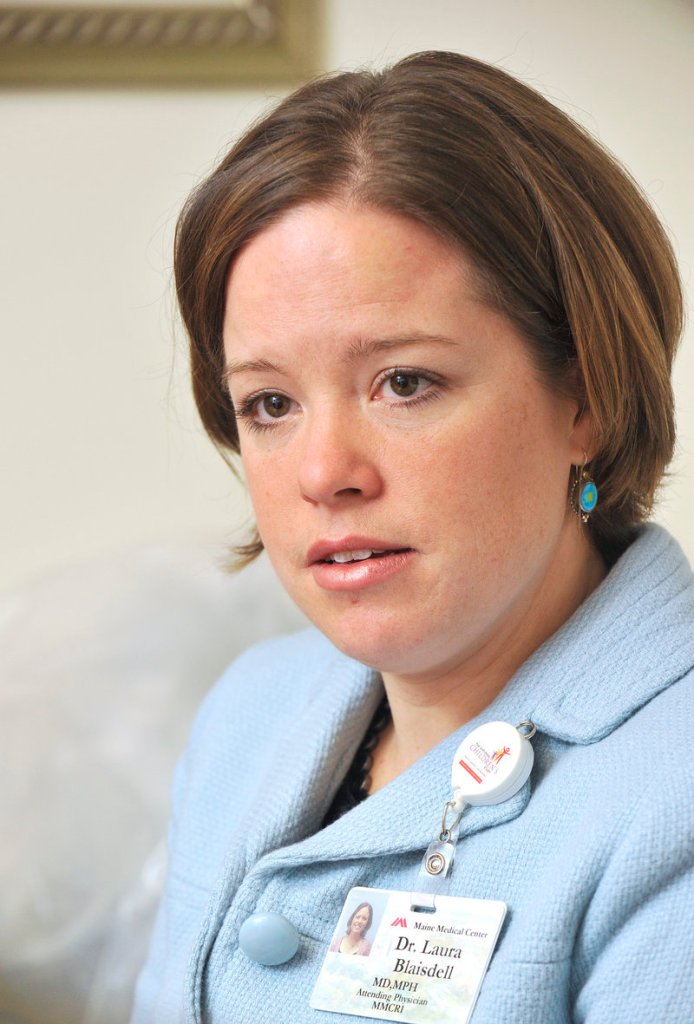PORTLAND – As pediatricians, John Bancroft and Laura Blaisdell get to watch a lot of children grow up into adults. And they know a lot about the problems kids can face along the way, from ear infections to asthma and autism.
But they may soon learn much more about the health threats facing kids. And they’re looking for some local families to help.
The physicians are part of a national team of medical researchers who plan to track the health of 100,000 yet-to-be-born American children for the first 21 years of their lives. Their piece of the historic study — known as the National Children’s Study — will be to track a total of 1,100 children in Cumberland County, the only county in northern New England selected as a sample site.
Maine Medical Center and its partners, including a geography professor from the University of Southern Maine and social science researchers from the University of Chicago, have been preparing to launch the Maine study for two years. Now they are about to start knocking on doors and recruiting women who are pregnant or may be soon.
If the project goes as planned — and Congress plans to spend billions of dollars to make sure it does — physicians such as Bancroft and Blaisdell could help solve troubling mysteries such as what is causing increases in autism and childhood diabetes.
“What things are we picking up from our air, our food?” Bancroft asked. “Why is it that we see more asthma than the national average here in Maine? We don’t know.”
And, Bancroft said, the study may find connections that doctors have not even considered between environmental factors and illnesses. “I’m prepared to be surprised,” he said.
LARGEST SUCH STUDY IN THE U.S.
Congress authorized the National Children’s Study in 2000 and has already spent more than $400 million on its planning and implementation. The cost is estimated to be $3 billion over 25 years, according to Bancroft.
The Maine Study Center, one of 37 around the country, received a $15 million five-year grant to begin the study of children in Cumberland County, he said.
It is the largest-ever longitudinal study of children’s health in the United States. Researchers will conduct periodic interviews and medical tests, such as urine samples, and will also track diets, behavior and environmental conditions, even the contents of dust in the home.
It will be purely observational. Participants won’t be asked to change their environment or their behavior.
“It’s really just looking at where kids learn, live and play,” Blaisdell said.
Blaisdell has two young children of her own and said parents have a lot of questions that could be answered by the study, such as: What are the effects of drinking from plastic baby bottles or living near high-tension wires or old waste dumps?
“There’s a big focus on the toxic environmental exposures to our children,” she said. “I get excited about having these discussions based on the best scientific knowledge.”
Blaisdell said she would have gladly volunteered for this study before her own children were born. “An opportunity to provide this information is not going to happen again in my lifetime,” she said.
‘ALMOST LIKE A DETECTIVE STORY’
Mothers who agree to participate will be compensated about $25 for each one-hour appointment. They or their children can refuse tests along the way and remain in the study. Children will be asked for their consent, too, as they get older.
There are strict confidentiality rules. Researchers will not disclose who is participating or even which neighborhoods have been chosen for recruiting.
Some of the findings may not be available to be shared with the families immediately, and researchers say participants will still need their own health care providers for regular care.
Cumberland County, while Maine’s most populous county, was chosen two years ago as one of the rural study sites. Since then, the research team has been studying the county and its residents.
USM geography professor Matthew Bampton began two years ago by plotting a map of every baby born in the county in the previous five years. Then he mapped all kinds of potential variables that could affect the health of those children.
“What sort of rocks are your houses based on? Where does your drinking water come from? How old is your house? All of these things have a spatial characteristic to them. They can all be mapped,” said Bampton.
His maps show where the hospitals are, where chemicals have been spilled and even where licensed hunters live. Families of hunters may be more likely to eat wild meat, as opposed to only supermarket meat. “It’s almost like a detective story. You try to put all these pieces together,” he said.
He had help from state agencies and other USM faculty, as well as his students.
“It is one of the most interesting and stimulating projects I’ve ever worked on,” said Bampton, who has three young daughters. “The benefits of doing a good job are so huge, it motivates me in a way other projects don’t.”
Based on Bampton’s maps, researchers chose 11 areas, or neighborhoods, that offer a diverse sample of the county. They contain a total of 16,419 households and range from rural communities to more urban neighborhoods, including at least two in Portland.
FIELD TEAM TO SEEK PARTICIPANTS
The locations of the neighborhoods are a secret, although the people who live in them are beginning to figure it out. Along with radio and print ads, researchers have sent a postcard and letters to the homes in the selected neighborhoods to inform residents about the study.
“the time we knock on the front door, they should have heard about the study,” said Carol Ewan Whyte, an epidemiologist affiliated with Maine Medical Center who is the study coordinator in Maine.
Whyte helps oversee a field research staff of 93 people who were hired and trained by experts from the University of Chicago. While the pediatricians will be involved at key points, the field team will do the bulk of the recruiting and field interviews to collect data.
This month, field research staffers will start knocking on doors, talking to residents and looking for women who are pregnant or might get pregnant soon, to join the project.
The project will start slowly, an effort to test and fine-tune research methods nationwide. One hundred mothers from Cumberland County will be chosen in the first round, with the actual study to begin next fall.
Starting in 2012, researchers will recruit 250 more families each year for four years.
Blaisdell and Bancroft, the pediatrician researchers, will meet with the first round of participants in the coming months. And they plan to pay close attention to their children for a long time to come.
“This is really an opportunity for us to contribute to the health of our next generation,” Bancroft said.
Staff Writer John Richardson can be contacted at 791-6324 or at:
jrichardson@pressherald.com
Send questions/comments to the editors.



